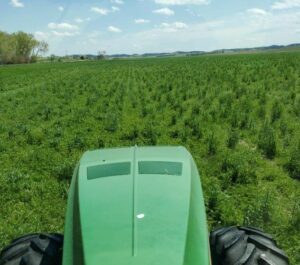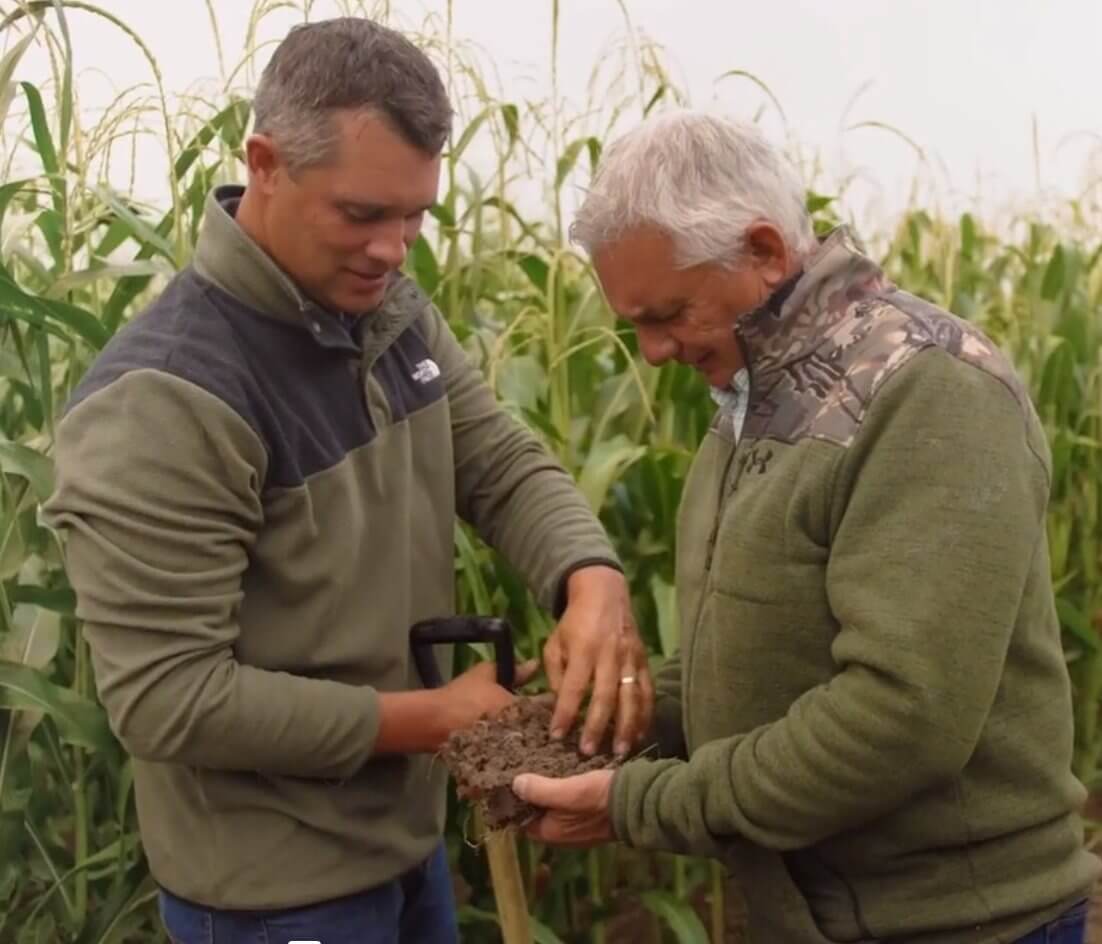Minimum Rainfall, Maximum Diversity
Jordan Carlson and his father Keith Carlson farm on the eastern edge of the Nebraska sandhills (Custer County) in a 20” rainfall region. Keith introduced no-till in the late 90’s and when Jordan joined the operation after college in 2008, they continued down the no-till path in order to save labor and moisture and not realizing the soil health benefits that had been accumulating over the years. Jordan recalls, “Initially our primary goal was to improve organic matter so we were less dependent on rainfall and inputs, but our goal soon broadened to improve the overall health of our soil. We quickly realized that no one could give us the answers we needed and that we had to learn and experiment on our own farm.”
Taking the Next Steps, Together
The Carlsons quickly realized they had to be more diverse than the standard corn-bean rotation to reach their soil health goals. After much experimentation and hard work, they now produce non-gmo corn, white popcorn, hairy vetch, cereal rye, buckwheat, oats, spring peas, and barley, while using diverse cover mixes wherever they can. As their farming operation has changed over the years, the importance of educating landowners has become clear. Jordan emphasizes, “Sometimes the neighbors will be pointing out to landowners the “disasters” that are happening on our fields. We take the time and educate our landowners so they understand what is happening on their property. When moments of misunderstanding arise, often stirred by neighbors, the opportunity to get a shovel in the ground will go a long way to helping them understand. It is about building their trust that we are looking after their property for the future. We are not trying to mine and take all we can from them, but build them something that will continue to improve with time.”
Rolling Vetch

Planting green directly into the hairy vetch cover crop takes some faith and high level management.
Jordan continues, “A part of our program that has huge potential, but also some risk is utilizing hairy vetch in a twin row system with a small amount of cereal rye. We wait as long as possible and plant our corn and roll the vetch down. Sometimes this feels like a mistake as the vetch is a solid web across the entire soil surface. This is definitely a situation where we have to explain to the landowner what is going on as the vetch is not fully terminated with the roller crimper until the corn is 6-12 inches tall. At times we refer to this as “scary vetch” not hairy vetch, but it has always worked out for us and the nitrogen fixation and the weed control from the vetch is outstanding.”
Walk of Faith
It is easy to talk about these practices in an interview, but at the end of the day it is a lot of work. Jordan remembers, “I was still hesitant to just go all in. It got to the point where it was so much work and where I was just basically burnt out. I knew that I was committed, but what it just boiled down to was “Do I trust God?’ I knew that I did, and I knew that it would be okay and we should just do it. Right after that we just did it and started with the twin row vetch after a cereal and before corn. By the grace of God I received a call from Walmart who wanted to visit our farm. I hesitated but we were convinced that they wanted to learn about how we were farming and we welcomed them to the farm. Once they got there we taught them with a shovel in the ground and the soil in their hands. Many steps later our regeneratively grown popcorn is now sold at Walmart stores nationwide. That has been very rewarding because if we did not take that step of faith and just do what God was calling us to do, we would have missed this opportunity. (To see more about Jordan’s operation, pick up a 2 lb bag of yellow popping corn in the Great Value bag and scan the QR code on the bag to see a video of how it is being grown.)


Place Yourself Around the Right People
When asked about advice to people wanting to get started, Jordan recommends, “Go to conferences and get motivated and excited but you have to remember that you have to apply them to your operation in your own way. Making connections can be great resources, but don’t forget to make connections locally also. Seek out the innovators in your area, and make friends with them. They may live 30 miles away, but they are living in the same environment and farming the same soils as you are and you can help each other in so many ways. Always keep your boots on and your shovel handy and never stop looking at your soils. That is the best way we can continue to improve our soil health.”
This article first appeared in the 10th Edition of Green Cover's Soil Health Resource Guide.
Dive into over 90 pages packed with scientific articles and fascinating stories from soil health experts, researchers, farmers, innovators, and more! All as our complimentary gift to you, a fellow soil health enthusiast!